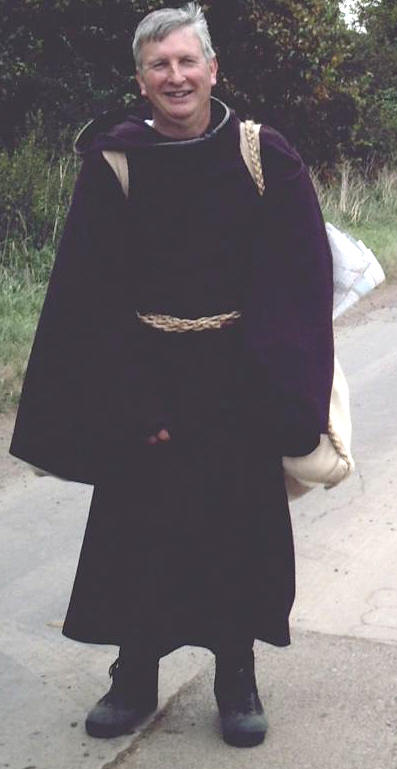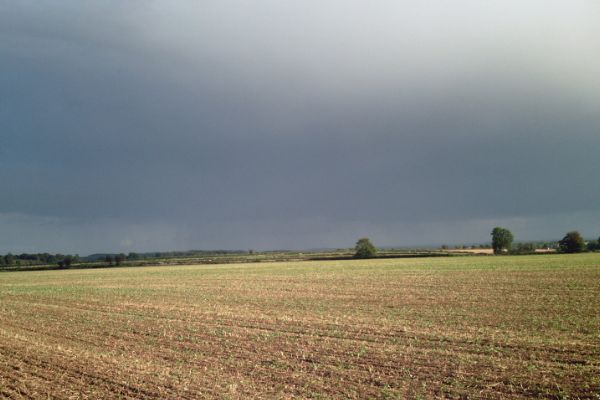
My belt was made of spun and platted twine which was also used for the shoulder bag.
On my back I had a bedding roll with a modern sleeping mat, a modern groundsheet plus spare sock, a pair of medieval shoes, a pair of braecs, a thick wool jumper and a few bits of food.
I had a shoulder bag in which I carried water and food, writing materials, camera plus a few emergency pieces such as a phone.
The bags were also of woven wool and made to an old pattern. The backpack was tied up with twine so that it stayed comfortably high on my back. The straps were extremely uncomfortable but I got used to them!

It is hard to capture an image of rain. If you value your camera and are trying to keep your clothing dry, the rain generally goes unrecorded. However, this ear-popping storm passed over on its way towards Peterborough and I am told that some people called it a tornado.
The journey was wet in the early stages. The wool for the habit, as well as the bags had all been treated with NikWax 'Polar Proof' treatment. This had the effect of restoring a lanolin-like wax to the wool. The result was that, although I was soaked many times, I was never cold inside the monk's habit. And the water quickly left the wool as I walked on.
The garment never felt waterlogged although it would clag to my legs when the wind blew hard enough. The treatment also meant that the backpack never became saturated and the contents were never 'wet'. I was very impressed by the treatment that kept me warm and comfortable in spite of the rain.
The challenge I faced each day was to make sure I was as dry as possible in the late afternoon. I know that I would get very cold if I tried to sleep with wet clothing. So 'teatime' often involved finding a secluded spot where everything could be allowed to dry. After that I would shelter from any rain, like the storm cloud pictured above.
Setting up camp
I don't have any images of the sleeping arrangements. Some mornings it was raining so I wouldn't risk the camera. One morning there was frost on the ground and I tried to use the self-timer but the light level too low to make a monk lying on the ground visible. So I am not surprised that horse riders and dog walkers passed nearby but never spotted me.
My routine when I stopped was this:
- I would find a wood, then by the light of the moon that was approaching full when I did the walk, I would select a spot that would keep me dry from above and below.
- Above, I would look for a good covering of leaves.
- Below I find that rabbit holes are a good pointer to land that stays dry.
- I would sweep the ground with my foot to clear sticks and stones and make sure it was level.
- My head was always near a tree, which I could use as a bed-head to lean against when I was getting organised.
- I liked to have a few low branches overhead to rig my windbreak and rain-catcher.
Setting up camp and getting settled took 5-10 minutes. The only interruptions to my slumber were caused by the rain.
Nightwear
With boots and sock removed, I put on some long, thick socks and a thick pair of trousers. I wore the thick wool jumper under the habit at night.
I had a thin, cotton sheet-bag which I carried because I do not like to be joined by things that creep, crawl and especially bite in the night. I would step inside this, lift it up around me which is much easier than trying to wriggle the habit down inside it.
With my back-pack as a pillow I would be asleep in minutes. I was woken by the sound of rain many times and would just check that everything was under cover since the rain would eventually pierce the leaf canopy. Not once did I wake because I was cold. Even when there was a frost, I was snug inside my habit.
The only time I got cold was each morning when I decided to have a good wash. In future I think I will leave my personal hygiene routine until later in the day.
During the day, it was possible to regulate my temperature by adjusting the hood, sleeves and length. As a sleeping bag, the habit is an excellent piece of kit.
- Folding the hood to provide a double layer of protection and a nice channel to warm the air I was breathing and so save precious heat-energy.
- The sleeves make an excellent duvet. With my hands reaching down to just about each knee, an arm inside the copious material created a great air-pocket which I am sure was the reason I stayed so warm. I took care to arrange my arms to provide this extra insulation before I fell asleep.
- I tried to 'spin' the fabric round my feet to seal that end and give extra layers of protection for the extremities. I suspect that the feet also stayed particularly warm as they repaired themselves after the days foot-slogging.